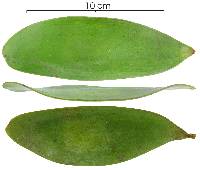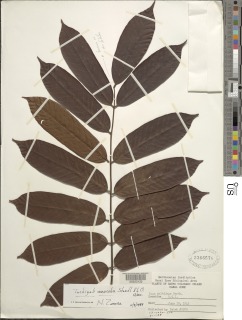

|
|
|
|
Family: Fabaceae
suicide tree, more... (es: alazano, Reseco)
[Tachigalia versicolor Standl. & L.O.Williams] |
Description: A tall forest tree, with large plank buttresses and a clean bole, unbranched until near the top. One of the tallest trees in the Canal area, reaching nearly 50 m in height. Bark is smooth, with a reddish brown color; the tops of the buttresses is especially reddish. Leaves are alternate, compound, with 14-16 leaflets that are in opposite pairs; no terminal leaflet; leaflets at base of leaf are reduced in size. Each leaflet is fairly large, over 10 cm long, and the entire leaf can be 50 cm or more. The leaf rachis is reddish with dense hairs. Saplings have a ribbed, reddish stem. At the growing tip is a stipule, usually reddish, that has the form of a miniature leaf -- with many tiny leaflets. Reproduction: This species has one of the most remarkable reproductive schedules of any tree in the world. When trees are very large, they finally reproduce for the first time, producing light brown flowers in clusters above the crown in April. These flowers dry over the next few months, and the seeds develop over the next year. At maturity, each seed has a large wing, more than 10 cm long, like a giant maple seed. Toward the end of the following dry season, the tree drops its leaves, and the seeds are shed into the wind. All of this is typical of many species in the area -- taking a year to mature seeds, then dropping leaves to disperse them in the wind. Now comes the strange part: the tree that just produced seeds never grows its leaves back, and slowly dies over the next few weeks. For months and then years after, the trunk remains, dropping branchlets, then branches. So a giant tree that takes more than a century to reach adulthood reproduces once and then dies. But there is more, additional complexity to the story: Tachigali as a population has peaks of flowering every 4-5 years, corresponding with El Niño events. Distribution: A common tree in old-growth and secondary forest at many sites from Summit Garden north. It is particularly common, for instance, on the hill adjacent to Gamboa, and every 4-5 years trees with flowers are easily spotted from the town. Tachigali is also common in the forests of Pipeline Rd, on Barro Colorado, Sherman, and can be found on the wetter forests of Santa Rita. Where found, saplings in the understory are numerous. Never seen in towns or along roads. Similar Species: As an adult, the smooth reddish plank buttresses along with smooth and straight reddish-brown trunk are a good characters. It is best also to learn the size and shape of the leaflets so the trunk characters can be confirmed. Saplings are easy to recognize from the ribbed reddish stem and peculiar, compound stipules at the growing tip. There are a couple other species that can be confused with Tachigali: One is LK taline Talisia nervosa, LK2 which has compound leaves and a peculiar compound stipule at the growing tip; the other is LK cupasc Cupania scrobiculata, LK2 which has a ribbed stem. The former does not have a reddish, ribbed stem, though, and the latter does not have the funny compound stipule. Descripción: Árbol de 20 a 40 m de alto. Copa amplia y redondeada, ramificada a gran altura. Ramitas terminales ligeramente cuadrangulares y surcadas. Tronco con raíces tablares muy delgadas que se extienden superficialmente a varios metros desde la base del árbol. Corteza exterior marrón o rojiza. En plantas juveniles el tronco es surcado y las hojas se concentran en el extremo apical. Hojas paripinnadas y alternas, con 6-9 pares de folíolos, opuestos en el raquis. Folíolos de 9-14 x 3-5 cm, oblongos o lanceolados, con ápice acuminado, bordes enteros y base redondeada. Los folíolos aumentan en tamaño hacia el extremo apical de las hojas. En plantas juveniles los folíolos presentan puntos circulares de color marrón castaño, lo cual se debe al ataque de hongos. Estípulas foliares. Pecíolo de 4-10 cm de largo y pulvinado en la base. Flores amarillas. Frutos en legumbres aplanadas y comprimidas, de 10-15 cm de largo, verdes, tornándose marrón castaño al madurar. Datos Ecológicos: La especie crece a bajas y medianas elevaciones, en lugares húmedos o muy húmedos. En Panamá se encuentra en las provincias de Coclé, Colón y Panamá. Deja caer parcialmente sus hojas alrededor de agosto y septiembre, pero las repone rápidamente. Los árboles de esta especie tienen un ciclo de vida monocárpico, por lo cual florecen y fructifican una sola vez en su vida, posteriormente mueren muy lentamente. La muerte de estos árboles ocasiona la abertura de claros grandes de forma natural en el bosque. Florecen y fructifican de julio a diciembre. Las flores son visitadas por abejas y otros insectos. En el suelo del bosque las semillas son atacadas por coleópteros, los cuales perforan la cubierta del fruto para depositar sus huevos. Especies Parecidas: A menudo se confunde con LK scleco Tachigali costaricensis LK2 , pero en T. costaricensis los folíolos son de mayor tamaño y presentan el envés ligeramente crema o amarillento. Usos: La madera es dura a semidura, empleada en la elaboración de muebles, postes de cercas y en la construcción en general. |
|
|
|




































